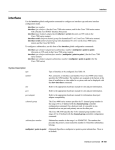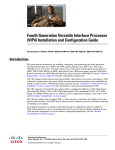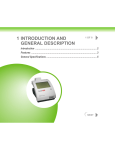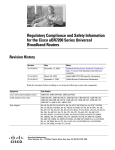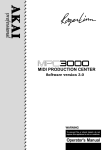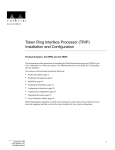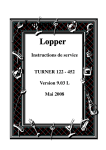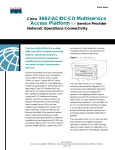Download Cisco ATM Cable Interface Processor ACIP-SM(=) Specifications
Transcript
Interface Processor Installation and Configuration Guide Customer Order Number: DOC-784211= Introduction This document contains installation and configuration procedures for interface processors installed in your Cisco 7000 series and Cisco 7500 series router. Interface processors support online insertion and removal (OIR), which allows interface processor insertion and removal without first shutting down the system to maximize router availability. For more complete information, refer to the specific installation and configuration guide for your interface processor at http://www.cisco.com/univercd/cc/td/doc/product/core/cis7505/interpro/index.htm, and the appropriate configuration note, or the appropriate Cisco IOS documentation, to more completely configure your interface processor. Contents This document includes the following sections: • Related Documentation, page 2 • Confirming Interface Processor Compatibility, page 4 • Interface Processor Description, page 7 • Installation Prerequisites, page 16 • Safety Guidelines, page 17 • Guidelines for Interface Processor Removal and Installation, page 21 • Interface Processor Installation Procedures, page 22 • Configuring the Interface Processor, page 28 • Upgrading Interface Processor Microcode Images, page 29 Corporate Headquarters: Cisco Systems, Inc., 170 West Tasman Drive, San Jose, CA 95134-1706 USA Copyright © 2002. Cisco Systems, Inc. All rights reserved. Related Documentation • Troubleshooting, page 32 • Obtaining Documentation, page 32 • Obtaining Technical Assistance, page 33 Related Documentation All of the following documentation mentioned is available online, on the Documentation CD-ROM, or as printed documents. For a complete list of documentation, refer to the Cisco 7500 Series Router Documentation flyer (part number DOC-7812955) that shipped with your interface processor, or view it online at http://www.cisco.com/univercd/cc/td/doc/product/core/cis7505/12955fly.htm. Your router and the Cisco IOS software running on it contain extensive features and functionality, which are documented in the following resources: • Cisco IOS software: For configuration information and support, refer to the Cisco IOS software configuration documentation set that corresponds to the software release installed on your Cisco hardware. • Refer to the following modular configuration and modular command reference publications, as appropriate for your configuration: – Configuration Fundamentals Configuration Guide – Configuration Fundamentals Command Reference – Security Configuration Guide – Security Command Reference – Wide-Area Networking Configuration Guide – Wide-Area Networking Command Reference – Network Protocols Configuration Guide, Parts 1, 2, and 3 – Network Protocols Command Reference, Parts 1, 2, and 3 – Bridging and IBM Networking Configuration Guide – Bridging and IBM Networking Command Reference – Configuration Builder Getting Started Guide – Troubleshooting Internetworking Systems – Debug Command Reference – System Error Messages – Cisco IOS Software Command Summary – Cisco Management Information Base (MIB) User Quick Reference Interface Processor Installation and Configuration Guide 2 78-4211-02 Related Documentation For additional information on configuring the Cisco 7000 series and Cisco 7500 series routers and interface processors, the following documentation resources are available: • Interface processors: For hardware installation and configuration information on each type of interface processor, refer to the following index of titles at www.cisco.com/univercd/cc/td/doc/product/core/cis7505/interpro/index.htm – ATM: www.cisco.com/univercd/cc/td/doc/product/core/cis7505/interpro/atm_/index.htm – Channel: www.cisco.com/univercd/cc/td/doc/product/core/cis7505/interpro/channel/index.htm – Dynamic Packet Transfer (DPT): www.cisco.com/univercd/cc/td/doc/product/core/cis7505/interpro/d_p_t/index.htm – Ethernet, Fast Ethernet, Gigabit Ethernet: www.cisco.com/univercd/cc/td/doc/product/core/cis7505/interpro/ethernet/index.htm – Fiber Distributed Data Interface (FDDI): www.cisco.com/univercd/cc/td/doc/product/core/cis7505/interpro/fddi/index.htm – High Speed Serial Interface (HSSI): www.cisco.com/univercd/cc/td/doc/product/core/cis7505/interpro/hssi/index.htm – Channelized: www.cisco.com/univercd/cc/td/doc/product/core/cis7505/interpro/ser_chan/index.htm – SONET: www.cisco.com/univercd/cc/td/doc/product/core/cis7505/interpro/sonet/index.htm – Token Ring: www.cisco.com/univercd/cc/td/doc/product/core/cis7505/interpro/token/index.htm • Cisco 7000 series routers: For hardware installation and maintenance information on the Cisco 7000 series routers, refer to the Cisco 7000 Hardware Installation and Maintenance Guide online at http://www.cisco.com/univercd/cc/td/doc/product/core/cis7000/7000_him/index.htm. • Cisco 7500 series routers: For hardware installation and maintenance information on the Cisco 7500 series routers, refer to the Quick Start Guide that shipped with your router, or refer to the Cisco 7500 Installation and Configuration Guide online at http://www.cisco.com/univercd/cc/td/doc/product/core/cis7505/cicg7500/index.htm. • For international agency compliance, safety, and statutory information for WAN interfaces: – Site Preparation and Safety Guide at http://www.cisco.com/univercd/cc/td/doc/product/lan/cat5000/hardware/safety/index.htm – Regulatory Compliance and Safety Information for the Cisco 7500 Series Routers at http://www.cisco.com/univercd/cc/td/doc/product/core/cis7505/4194pc75.htm • To view Cisco documentation or obtain general information about the documentation, refer to the following sources: – World Wide Web, page 32 – Documentation CD-ROM, page 32 – Ordering Documentation, page 33 Interface Processor Installation and Configuration Guide 78-4211-02 3 Confirming Interface Processor Compatibility – Documentation Feedback, page 33 – Cisco.com, page 33 – Technical Assistance Center, page 34 Confirming Interface Processor Compatibility This section describes how to determine if your interface processor is compatible with your existing equipment. This section includes the following information: Process Flowchart, page 4 Determining Board Part Number and Revision, page 5 Process Flowchart Before installing a new interface processor, determine if it is compatible with your existing legacy interface processors, using the following flowchart (Figure 1) in conjunction with Table 1. To determine your board number and revision, refer to the “Determining Board Part Number and Revision” section on page 5. Interface Processor Compatibility Flowchart Do you have an EIP, FIP, FSIP, or AIP that you want to install in your router? Yes Did you receive your EIP, FIP, or FSIP before January 1995? Did you receive your AIP before March 1995? No Yes No Yes No For pricing or ordering information, contact your Cisco representative or call 408 526-7355 and reference the Investment Protection Program (IPP). Your interface processors are compatible Table 1 Does your EIP, FIP, FSIP, or AIP have part number and board revision level earlier than listed in the Compatibility Guidelines Table? P1141 Figure 1 Interface Processor Compatibility Guidelines 1 Product Number Board Part Number 2 Board Revision 3 4 5 CX-AIP-SS 73-1188-02 D0 or later CX-AIP-SM 73-1188-02 D0 or later CX-AIP-TM 73-1188-02 D0 or later CX-AIP-DS3 - Does not require an upgrade Interface Processor Installation and Configuration Guide 4 78-4211-02 Confirming Interface Processor Compatibility Table 1 Interface Processor Compatibility Guidelines 1 (continued) Product Number Board Part Number 2 Board Revision 3 4 5 CX-AIP-E3 - Does not require an upgrade CX-EIP2 73-1129-02 N0 or later CX-EIP4 73-1132-02 N0 or later CX-EIP6 73-0906-02 N0 or later CX-FIP-MM 73-0892-03 M0 or late CX-FIP-MS 73-1093-03 M0 or later CX-FIP-SM 73-1090-03 M0 or later CX-FIP-SS 73-1087-03 M0 or later CX-FSIP4 73-1187-05 A0 or later CX-FSIP8 73-1126-05 A0 or later All other interface processors - - 1. Any interface processors not specifically listed in the table are compatible with Cisco 7500 series or RSP7000. 2. A board part number is compatible with Cisco 7500 series or Cisco 7000 series with an RSP7000 processor option if it is equal to or greater than those listed in this column. 3. The suffix of the part number reflects the fab revision. (See the “Determining Board Part Number and Revision” section on page 5) 4. It may not be necessary to check the board revision level, because the part number suffix itself may determine compatibility. 5. A board revision should be checked only if the part number suffix is equal to those listed in the table. In this case, the board revision must be greater than or equal to those listed in the table. Determining Board Part Number and Revision You can determine the part number and board revision of your interface processor in one of two ways: • Inspect the physical board • Use the show diagbus command online Figure 2 provides a flowchart to determine if your new interface processor is compatible with your existing interface processor, using board part numbers and revision levels. Interface Processor Installation and Configuration Guide 78-4211-02 5 Confirming Interface Processor Compatibility Determining Compatibility from Board Part Numbers and Revision Levels Is your part number suffix lower than required? Is your part number suffix equal to required? No Yes IPP upgrade required No Is your part number suffix higher than required? Yes No Is your board revision equal or higher than required? Yes Yes No upgrade required P1124 Figure 2 Inspecting the Physical Board The part number and board revision are typically silk-screened along an edge of the interface processor printed circuit board, as shown in Figure 3: Diagram of Interface Processor, Board, and Carrier 73- 1129 - 02 REV M0 Interface processor board edge Carrier edge P1122 Figure 3 Using the Show Diagbus Command You can also use the show diagbus command to determine the part number and board revision of your interface processor. The following is an example of a compatible CX-EIP6: Router# show diagbus Slot 0: Physical slot 0, ~physical slot 0xF, logical slot 0, CBus 0 Microcode Status 0x0 Master Enable, LED, WCS Loaded Board is analyzed EEPROM format version 1 EIP controller, HW rev 1.5, board revision B0 Serial number: 01652924 Part number: 73-0906-04 Test history: 0x00 RMA number: 00-00-00 Flags: cisco 7000 board; 7500 compatible EEPROM contents (hex): 0x20: 01 00 01 05 00 19 38 BC 49 03 8A 04 00 00 00 00 0x30: 58 00 00 00 00 00 00 00 00 00 00 00 00 00 00 00 Slot database information: Flags: 0x4 Insertion time: 980 (5d20 ago) Interface Processor Installation and Configuration Guide 6 78-4211-02 Interface Processor Description Interface Processor Description This section describes interface processors and includes the following information: • Interface Processor Descriptions and Part Numbers, page 9 • LEDs, page 11 • Slot Locations in the Cisco 7000 and Cisco 7500 Series Routers, page 11 • Cables, page 14 • Specifications, page 15 Interface processors are modular, self-contained boards with one or more network interface connectors between the system bus (inside Cisco 7000 series and Cisco 7500 series routers) and the network. Interface processors have one network connection (see Figure 4). Versatile Interface Processors (VIPs) support up to two network connections via the port adapters (see Figure 5). However, the focus of this guide is interface processors. For more information on second generation VIPs (VIP2s), refer to http://www.cisco.com/univercd/cc/td/doc/product/core/cis7505/vip1/vip2/index.htm. For more information on fourth generation VIPs (VIP4s), refer to http://www.cisco.com/univercd/cc/td/doc/product/core/cis7505/vip1/vip4/index.htm. Figure 4 Single-Port Interface Processor Example - High-Speed Serial Interface Processor Shown 70579 U133, microcode ROM Interface Processor Installation and Configuration Guide 78-4211-02 7 Interface Processor Description Figure 5 Dual-Port Interface Processor Example - VIP2-40 with an FE-TX Port Adapter and a Blank Port Adapter Shown Bus connector CPU Boot ROM U6 SRAM DIMM U5 U4 DRAM SIMMs U2 PA-FE-TX port adapter slot 1 PA-FE-TX in port adapter slot 0 70580 FAST ETHERNET 0 0 FAST ETHERNET Port adapter handles not shown Interface processors provide the following electrical interface media: • Asynchronous Transfer Mode (ATM) • Basic Rate Interface (BRI) • Channel attachment • Channelized E1, T1, and T3 • Ethernet • Fast Ethernet (FE) • Fiber Distributed Data Interface (FDDI) • High-Speed Serial Interface (HSSI) • Multichannel • Primary Rate Interface (PRI) • Packet over OC-3 • Synchronous serial • Token Ring • Dynamic Packet Transport (DPT) Interface Processor Installation and Configuration Guide 8 78-4211-02 Interface Processor Description Interface Processor Descriptions and Part Numbers Table 2 lists the interface processors by type, with descriptions and part numbers. Table 2 Interface Processor Descriptions and Part Numbers Interface Processor Description Part Number ATM Interface Processors: AIP ACIP ATM Interface Processor, 1 TAXI multimode port, 100 Mbps CX-AIP-TM ATM Interface Processor, 1 SONET/SDH single-mode port, 155 Mbps CX-AIP-SS ATM Interface Processor, 1 E3 coaxial port, 34 Mbps CX-AIP-E3 ATM Cable Interface Processor, 1 SONET/SDH multimode port, 155 Mbps CX-ACIP-SM Channel Interface Processors: CIP2 Second-generation Channel Interface Processor with single parallel channel CX-CIP2-PCA11 Second-generation Channel Interface Processor with dual parallel channel CX-CIP2-PCA2 1 Second-generation Channel Interface Processor with single ESCON channel CX-CIP2-ECA1 Second-generation Channel Interface Processor with dual ESCON channel CX-CIP2-ECA2 Second-generation Channel Interface Processor with single ESCON channel CX-CIP2-ECAP11 and single parallel channel CT3IP CT3IP-50 Channelized T3 Interface Processor, 1 port, 1 MB SRAM, 16 MB DRAM CT3IP-20 Channelized T3 Interface Processor, 1 port, 2 MB SRAM, 32 MB DRAM CT3IP-40 Channelized DS3 Interface Processor, Model 50, 4 MB SRAM, 32 MB SDRAM CT3IP-50 May be ordered with the following memory options: 8 MB SRAM Option for MEM-VIP250-8M-S VIP2-50 (Packet Memory) 64 MB SDRAM Option for VIP2-50 (Program MEM-VIP250-64M-D Memory) 128 SDRAM Option for VIP2-50 (Program Memory) MEM-VIP250-128M-D Dynamic Packet Transport OC12/STM4 (SRPIP) Interface Processor: SRPIP 2xOC12/STM4c Multi-mode SRPIP-OC12MM Dynamic Packet Transport Interface Processor - OC12SMI SRPIP-OC12SMI= Dynamic Packet Transport Interface Processor - OC12SML SRPIP-OC12SML DPT-OC12 Single-mode extended reach Interface Processor SRPIP-OC12SMX Single-Mode, Intermediate Reach Ring Interface Processor SRPIP-OC12SI Single-Mode, Long-Reach Ring Interface Processor SRPIP-OC12SL Ethernet Interface Processors: EIP Ethernet Interface Processor, 2 ports CX-EIP2 Ethernet Interface Processor, 4 ports CX-EIP4 Ethernet Interface Processor, 6 ports CX-EIP6 Interface Processor Installation and Configuration Guide 78-4211-02 9 Interface Processor Description Table 2 Interface Processor Descriptions and Part Numbers (continued) Interface Processor Description Part Number Fast Ethernet Interface Processors: FEIP2 Second-Generation Fast Ethernet Interface Processor, 2 ports FEIP2-2TX Second-Generation Fast Ethernet Interface Processor, 2 ports FEIP2-2FX 2-Port Fast Ethernet IP with Dist. Switching (100TX) FEIP2-DSW-2TX 2-Port Fast Ethernet IP with Dist. Switching (100FX) FEIP2-DSW-2FX FDDI Interface Processors: FIP FSIP FDDI Interface Processor, 1 multimode to single-mode port CX-FIP-MS FDDI Interface Processor, 1 single-mode to multimode port CX-FIP-SM Fast Serial Interface Processor, 4 ports CX-FSIP4 Fast Serial Interface Processor, 8 ports CX-FSIP8 Gigabit Ethernet Interface Processor: GEIP Gigabit Ethernet Interface Processor GEIP Enhanced Gigabit Ethernet Interface Processor GEIP+ MultiChannel Interface Processors MIP MultiChannel Interface Processor, 1-port T1/PRI CX-MIP-1CT1 SMIP Service Provider MultiChannel Interface Processor, 2 T1 or ISDN PRI ports CX-SMIP-2CT1 Serial Interface Processors FSIP SSIP Fast Serial Interface Processor, 4 ports CX-FSIP4 Fast Serial Interface Processor, 8 ports CX-FSIP8 Standard Serial Interface Processor, 8-port CX-SSIP8 Token Ring Interface Processors TRIP Token Ring Interface Processor, 2-port CX-TRIP2 SONET Interface Processor POSIP Packet OC-3 Interface Processors POSIP Packet OC-3 Interface Processor, 1 single-mode port, 1 MB SRAM, 16 MB POSIP-OC3-20-SM DRAM Packet OC-3 Interface Processor, 1 multimode port, 1 MB SRAM, 16 MB DRAM POSIP-OC3-20-MM Packet OC-3 Interface Processor, 1 single-mode port, 2 MB SRAM, 32 MB POSIP-OC3-40-SM DRAM Packet OC-3 Interface Processor, 1 multimode port, 2 MB SRAM, 32 MB DRAM POSIP-OC3-40-MM Packet OC-3 Interface Processor, 1 single-mode port, 4 to 8 MB SRAM, 32 POSIP-OC3-50-SM to 128 MB SDRAM Packet OC-3 Interface Processor, 1 multimode port, 4 to 8 MB SRAM, 32 to POSIP-OC3-50-MM 128 MB SDRAM 1. CX-CIP2-PCA1, CX-CIP2-PCA2, and CX-CIP2-ECAP1 ship with a cable that connects the CIP2 to cable CAB-PCA-VA. Cable CAB-PCA-VA provides the physical connection to the IBM bus and tag cable. Cable CAB-PCA-VA is required and is a standard IBM cable. Interface Processor Installation and Configuration Guide 10 78-4211-02 Interface Processor Description LEDS The interface processor has several status LEDs on its faceplate, next to each port, which indicate conditions on that port. (See Figure 6.) After system initialization, the enabled LED goes on to indicate that the FSIP has been enabled for operation. The following conditions must be met before the interface processor is enabled: • The interface processor microcode is valid and has been downloaded successfully. • The interface processor is correctly connected to the backplane and is receiving power. • The system bus recognizes the interface processor. If any one of these conditions is not met, or if the initialization fails, the enabled LED does not go on. Refer to the specific installation and configuration guide for your interface processor at http://www.cisco.com/univercd/cc/td/doc/product/core/cis7505/interpro/index.htm to more completely understand the LEDs for your interface processor. Figure 6 LEDs on a GEIP+ Example—Partial Faceplate View Shown X R TX 38585 EN AB LE D LI N K ENHANCED GIGABIT ETHERNET TX RX Slot Locations in the Cisco 7000 and Cisco 7500 Series Routers Interface processors are installed in the interface processor slots of the Cisco 7000 series and Cisco 7500 series routers. Interface processors are keyed so they cannot be installed in noninterface processor slots, that is the route switch processor (RSP) slots. The interface processor slots in the Cisco 7000 series and Cisco 7500 series routers are as follows: Note • Cisco 7000—slots 0 through 4 (See Figure 7.) • Cisco 7010—slots 0 through 2 (See Figure 8.) • Cisco 7505—slots 0 through 3 (See Figure 9.) • Cisco 7507—slots 0 and 1, and slots 4 through 6 (See Figure 10.) • Cisco 7513—slots 0 through 5, and slots 8 through 12 (See Figure 11.) • Cisco 7576—slots 0 through 5, and slots 8 through 12 (See Figure 11.) The interface processor slots are oriented horizontally in the Cisco 7010 and Cisco 7505, and vertically in the Cisco 7000, Cisco 7507, Cisco 7513 and Cisco 7576. Interface Processor Installation and Configuration Guide 78-4211-02 11 Interface Processor Description Figure 7 Cisco 7000 Interface Processor Slots - Rear View Captive installation screw DC AC FA IL PO WE EN R AB LE NO RM AL Upper power supply EJ EC T I SL SLO OT T 0 1 O Captive installation screw CP U EN AB HA LT LE RE SE T DC AC FA IL PO WE R Lower power supply AU NS OL E I ROUTE SWITCH PROCESSOR CO H5288 X. O Interface processor slots Figure 8 1 0 2 3 4 RSP RSP 7000 7000CI slot 5 slot 6 Cisco 7010 Interface Processor Slots - Rear View RSP7000CI slot 4 RSP7000 slot 3 T HA L LE NS O CO AU X. CP U RE S ET Interface processor slot 2 AB EN EN AB LE LE EJ EC T SL SLO OT T 0 1 NO R MA L ROUTE SWITCH PROCESSOR Interface processor slot 1 Interface processor slot 0 Power switch H5874 DC OK LED Chassis ground screw Power receptacle AC-input power supply Interface Processor Installation and Configuration Guide 12 78-4211-02 Interface Processor Description CO NS OL E AU X. HA LT RE SE T CP U RSP slot ROUTE SWITCH PROCESSOR Interface processor slot 3 EN AB LE EN AB LE NO RM SL SLO OT T 0 1 EJ EC T Cisco 7505 Interface Processor Slots - Rear View AL Figure 9 Interface processor slot 2 Interface processor slot 1 Interface processor slot 0 H2761 Power switch Chassis grounding receptacles Power receptacle Figure 10 DC OK LED AC-input power supply Cisco 7507 Interface Processor Slots - Rear View Captive installation screw DC AC FA IL PO WE R EN NO AB RM LE AL Upper power supply Chassis grounding receptacles EJ EC T SL SLO OT T 0 1 I SL MA AV ST E ER O SL AV E/M AS TE R Captive installation screw CP U HA LT EN AB RE LE SE T DC AC FA IL PO WE H3888 R Lower power supply AU X. NS OL E I ROUTE SWITCH PROCESSOR 2 CO O Slot 0 1 2 3 4 5 6 RSP slots Interface Processor Installation and Configuration Guide 78-4211-02 13 Interface Processor Description Figure 11 Cisco 7513 and Cisco 7576 Interface Processor Slots - Rear View Blower module Cable-management bracket NO RM AL EN AB LE EJE CT SLO SLO T0 T1 SLA MAS VE TE R Card cage and processor modules SLA VE /M AS TE R CP U HA LT RE SE EN T AB LE AU OLE Interface processor slots 0 1 2 3 4 5 ROUTE SWITCH PROCESSOR 2 NS H10000 X. CO 8 9 10 11 12 Cables This section describes the interface processor cables, and lists part numbers for each. Refer to the specific installation and configuration guide for your interface processor for additional information. Table 3 Cisco 7000 Series and Cisco 7500 Series Interface Processor Cables Interface Processor Cable Description Part Number AIP - For DS3/E3, use CAB-ATM-DS3/E3 Other cables are user supplied CIP2 Y cable that comes with CIP2 PCA V cable A PCA V cable B CAB-PCA-Y 1 CAB-PCA-VA1 CAB-PC-VB1 CT3IP - User supplied EIP - User supplied FEIP - User supplied FEIP2 - User supplied FIP Mini-DIN-to-DIN transition CAB-FMDD= Interface Processor Installation and Configuration Guide 14 78-4211-02 Interface Processor Description Table 3 Cisco 7000 Series and Cisco 7500 Series Interface Processor Cables (continued) Interface Processor Cable Description Part Number FSIP SSIP VIP-4E/4T2 VIP-4R/4T2 X.21 high-density male DTE X.21 high-density female DCE EIA/TIA-449 high-density male DTE EIA/TIA-449 high-density female DCE V.35 high-density male DTE V.35 high-density female DCE EIA/TIA-232 high-density male DTE EIA/TIA-232 high-density female DCE EIA-530 high-density male DTE E1-G.703/G.704 twinax 120-ohm balanced, 16.4 ft E1-G.703/G.704 DB-15 120-ohm balanced, 16.4 ft E1-G.703/G.704 BNC 75-ohm unbalanced, 16.4 ft CAB-X21MT CAB-X21FC CAB-449MT CAB-449FC CAB-V35MT CAB-V35FC CAB-232MT CAB-232FC CAB-530MT CAB-EI-TWINAX CAB-EI-DB15 CAB-EI-BNC HIP3 Null modem, DTE, HSSI, 10 ft Male to male, 10 ft CAB-HNUL= CAB-HSI1= MIP or SMIP DSX1 to CSU DB-15 thru DSX1 to CSU DB-15 null E1 ISDN PRI, 10 ft E1 BNC 75-ohm unbalanced, 16.4 ft E1 DB15 120-ohm balanced, 16.4 ft E1 TWINAX 120-ohm balanced, 16.4 ft CAB-7KCT1DB15 CAB-7KCT1NULL CAB-E1-PRI CAB-E1-BNC CAB-E1-DB15 CAB-E1-TWINAX POSIP - User supplied TRIP - User supplied 1. CIP2 models CX-CIP2-PCA1, CX-CIP2-PCA2, and CX-CIP2-ECAP1 ship with a cable that connects the CIP2 to cable CAB-PCA-VA 2. First generation VIP is no longer available. For informational purposes only. 3. The HIP uses the same cables as the PA-H and PA-2H port adapters. Specifications The interface processor physical specifications are listed in Table 4. Table 4 Interface Processor Specifications Description Specifications Physical dimensions The IP occupies one chassis slot and can only be operated in a Cisco 7500 series, or Cisco 7000 series routers using the 7000 Series Route Switch Processor (RSP7000) and 7000 Series Chassis Interface (RSP7000CI) Shipping weight 5 lb (2.25 kg) Operating temperature 32 to 104˚F (0 to 40˚C) Relative humidity 10 to 90%, noncondensing Storage temperature -4 to 149˚F (-20 to 65˚C) Interface Processor Installation and Configuration Guide 78-4211-02 15 Installation Prerequisites Installation Prerequisites This section provides important prerequisites you should observe regarding interface processor software, hardware, and microcode. • Hardware Prerequisites, page 16 • Software Prerequisites, page 16 • Microcode Prerequisites, page 16 • List of Required Parts and Tools, page 17 Hardware Prerequisites Interface processors operate in the Cisco 7000 or Cisco 7500 series routers with either of the following processor types: • Interface processors operate with the CxBus in the Cisco 7000 series routers with either of the following processor types: – Route Processor (RP) and Switch Processor (SP) (or Silicon Switch Processor [SSP]) combination – 7000 Series Route Processor (RSP7000) and 7000 Series Chassis Interface (RSP7000CI) combination • Interface processors also operate with the CyBus in the Cisco 7500 series routers, which use the Route Switch Processor (RSP). Software Prerequisites For the specific minimum software requirements for your interface processor, refer to the Software Advisor at http://www.cisco.com/cgi-bin/Support/CompNav/Index.pl, and the installation and configuration guide for your specific interface processor at http://www.cisco.com/univercd/cc/td/doc/product/core/cis7505/interpro/index.htm. Microcode Prerequisites Microcode, also known as firmware, is a set of processor-specific software instructions that enables and manages the features and functions of a specific processor type. At system startup or reload, the system loads the microcode for each processor type present in the system. The interface processor microcode boot image resides in a Flash memory device on the interface processor motherboard. The entire interface processor microcode image is delivered on a Flash memory card, on floppy disks, or is available via download from Cisco.com. New microcode is released to enable new features, improve performance, or fix bugs in earlier versions. The Cisco 7000 series and Cisco 7500 series routers feature downloadable software and microcode for most upgrades. These features enable you to download new (upgraded) images remotely, store the images in router memory, and load the new images at system startup without having to physically access the router. You can store multiple versions for a specific processor type in Flash memory, and use configuration commands to specify which version the system should load at startup. All interfaces of the same type (for example, all CIP2s) use the same microcode image. Interface Processor Installation and Configuration Guide 16 78-4211-02 Safety Guidelines Caution To ensure proper operation of the interface processor, and to preclude system problems, you should use only the interface processor microcode image that is recommended for the version of Cisco IOS software you are running (refer to the Software Advisor at http://www.cisco.com/cgi-bin/Support/CompNav/Index.pl) or refer to the installation and configuration guide for your specific interface processor at http://www.cisco.com/univercd/cc/td/doc/product/core/cis7505/interpro/index.htm. By default, the interface processor microcode is loaded from either onboard Flash memory (if you have a Cisco 7000 or Cisco 7010 router with an RP) or the Flash memory card in slot0 for the Cisco 7500 series routers. The default interface processor microcode version can be found by entering the show microcode command. The following is a partial-display example of the show microcode command output for a second generation channel interface processor (CIP2): Router# show microcode Microcode bundled in system Card Microcode Type Version device:filename -----------------------------(additional display text omitted from this example) CIP2 22-15 slot0:cip22-15 (additional display text omitted from this example) Microcode flash default images List of Required Parts and Tools Following are the tools required for interface processor replacement: • An interface processor, or an interface processor filler, if you are removing an interface processor and not replacing it • Number 1 Phillips or 3/16-inch flat-blade screwdriver for the captive installation screws on the interface processors • Antistatic mat or foam pad, or an antistatic bag, on or in which to place removed interface processors • Your own ESD grounding strap or the disposable ESD strap included with your system Safety Guidelines Following are safety guidelines that you should follow when working with any equipment that connects to electrical power or telephone wiring. This section also includes safety and ESD-prevention guidelines to help you avoid injury and damage to the equipment. Warning Only trained and qualified personnel should be allowed to install or replace this equipment. Interface Processor Installation and Configuration Guide 78-4211-02 17 Safety Guidelines Safety Warnings Warning This warning symbol means danger. You are in a situation that could cause bodily injury. Before you work on any equipment, be aware of the hazards involved with electrical circuitry and be familiar with standard practices for preventing accidents. To see translations of the warnings that appear in this publication, refer to the Regulatory Compliance and Safety Information document that accompanied this device. Waarschuwing Dit waarschuwingssymbool betekent gevaar. U verkeert in een situatie die lichamelijk letsel kan veroorzaken. Voordat u aan enige apparatuur gaat werken, dient u zich bewust te zijn van de bij elektrische schakelingen betrokken risico's en dient u op de hoogte te zijn van standaard maatregelen om ongelukken te voorkomen. Voor vertalingen van de waarschuwingen die in deze publicatie verschijnen, kunt u het document Regulatory Compliance and Safety Information (Informatie over naleving van veiligheids- en andere voorschriften) raadplegen dat bij dit toestel is ingesloten. Varoitus Tämä varoitusmerkki merkitsee vaaraa. Olet tilanteessa, joka voi johtaa ruumiinvammaan. Ennen kuin työskentelet minkään laitteiston parissa, ota selvää sähkökytkentöihin liittyvistä vaaroista ja tavanomaisista onnettomuuksien ehkäisykeinoista. Tässä julkaisussa esiintyvien varoitusten käännökset löydät laitteen mukana olevasta Regulatory Compliance and Safety Information -kirjasesta (määräysten noudattaminen ja tietoa turvallisuudesta). Attention Ce symbole d'avertissement indique un danger. Vous vous trouvez dans une situation pouvant causer des blessures ou des dommages corporels. Avant de travailler sur un équipement, soyez conscient des dangers posés par les circuits électriques et familiarisez-vous avec les procédures couramment utilisées pour éviter les accidents. Pour prendre connaissance des traductions d’avertissements figurant dans cette publication, consultez le document Regulatory Compliance and Safety Information (Conformité aux règlements et consignes de sécurité) qui accompagne cet appareil. Warnung Dieses Warnsymbol bedeutet Gefahr. Sie befinden sich in einer Situation, die zu einer Körperverletzung führen könnte. Bevor Sie mit der Arbeit an irgendeinem Gerät beginnen, seien Sie sich der mit elektrischen Stromkreisen verbundenen Gefahren und der Standardpraktiken zur Vermeidung von Unfällen bewußt. Übersetzungen der in dieser Veröffentlichung enthaltenen Warnhinweise finden Sie im Dokument Regulatory Compliance and Safety Information (Informationen zu behördlichen Vorschriften und Sicherheit), das zusammen mit diesem Gerät geliefert wurde. Avvertenza Questo simbolo di avvertenza indica un pericolo. La situazione potrebbe causare infortuni alle persone. Prima di lavorare su qualsiasi apparecchiatura, occorre conoscere i pericoli relativi ai circuiti elettrici ed essere al corrente delle pratiche standard per la prevenzione di incidenti. La traduzione delle avvertenze riportate in questa pubblicazione si trova nel documento Regulatory Compliance and Safety Information (Conformità alle norme e informazioni sulla sicurezza) che accompagna questo dispositivo. Interface Processor Installation and Configuration Guide 18 78-4211-02 Safety Guidelines Advarsel Dette varselsymbolet betyr fare. Du befinner deg i en situasjon som kan føre til personskade. Før du utfører arbeid på utstyr, må du vare oppmerksom på de faremomentene som elektriske kretser innebærer, samt gjøre deg kjent med vanlig praksis når det gjelder å unngå ulykker. Hvis du vil se oversettelser av de advarslene som finnes i denne publikasjonen, kan du se i dokumentet Regulatory Compliance and Safety Information (Overholdelse av forskrifter og sikkerhetsinformasjon) som ble levert med denne enheten. Aviso Este símbolo de aviso indica perigo. Encontra-se numa situação que lhe poderá causar danos físicos. Antes de começar a trabalhar com qualquer equipamento, familiarize-se com os perigos relacionados com circuitos eléctricos, e com quaisquer práticas comuns que possam prevenir possíveis acidentes. Para ver as traduções dos avisos que constam desta publicação, consulte o documento Regulatory Compliance and Safety Information (Informação de Segurança e Disposições Reguladoras) que acompanha este dispositivo. ¡Advertencia! Varning! Este símbolo de aviso significa peligro. Existe riesgo para su integridad física. Antes de manipular cualquier equipo, considerar los riesgos que entraña la corriente eléctrica y familiarizarse con los procedimientos estándar de prevención de accidentes. Para ver una traducción de las advertencias que aparecen en esta publicación, consultar el documento titulado Regulatory Compliance and Safety Information (Información sobre seguridad y conformidad con las disposiciones reglamentarias) que se acompaña con este dispositivo. Denna varningssymbol signalerar fara. Du befinner dig i en situation som kan leda till personskada. Innan du utför arbete på någon utrustning måste du vara medveten om farorna med elkretsar och känna till vanligt förfarande för att förebygga skador. Se förklaringar av de varningar som förkommer i denna publikation i dokumentet Regulatory Compliance and Safety Information (Efterrättelse av föreskrifter och säkerhetsinformation), vilket medföljer denna anordning. Electrical Equipment Guidelines Follow these basic guidelines when working with any electrical equipment: • Before beginning any procedures requiring access to the chassis interior, locate the emergency power-off switch for the room in which you are working. • Disconnect all power and external cables before moving a chassis. • Do not work alone when potentially hazardous conditions exist. • Never assume that power has been disconnected from a circuit; always check. • Do not perform any action that creates a potential hazard to people or makes the equipment unsafe. • Carefully examine your work area for possible hazards such as moist floors, ungrounded power extension cables, and missing safety grounds. Telephone Wiring Guidelines Use the following guidelines when working with any equipment that is connected to telephone wiring or to other network cabling: • Never install telephone wiring during a lightning storm. Interface Processor Installation and Configuration Guide 78-4211-02 19 Safety Guidelines • Never install telephone jacks in wet locations unless the jack is specifically designed for wet locations. • Never touch uninsulated telephone wires or terminals unless the telephone line has been disconnected at the network interface. • Use caution when installing or modifying telephone lines. Preventing Electrostatic Discharge Damage Electrostatic discharge (ESD) damage, which can occur when electronic cards or components are improperly handled, results in complete or intermittent failures. Port adapters and processor modules consist of printed circuit boards that are fixed in metal carriers. Electromagnetic interference (EMI) shielding and connectors are integral components of the carrier. Although the metal carrier helps to protect the board from ESD, use a preventive antistatic strap during handling. Following are guidelines for preventing ESD damage: Caution • Always use an ESD wrist or ankle strap and ensure that it makes good skin contact. • Connect the equipment end of the strap to an unfinished chassis surface. • When installing a component, use any available ejector levers or captive installation screws to properly seat the bus connectors in the backplane or midplane. These devices prevent accidental removal, provide proper grounding for the system, and help to ensure that bus connectors are properly seated. • When removing a component, use any available ejector levers or captive installation screws to release the bus connectors from the backplane or midplane. • Handle carriers by available handles or edges only; avoid touching the printed circuit boards or connectors. • Place a removed component board-side-up on an antistatic surface or in a static shielding container. If you plan to return the component to the factory, immediately place it in a static shielding container. • Avoid contact between the printed circuit boards and clothing. The wrist strap only protects components from ESD voltages on the body; ESD voltages on clothing can still cause damage. • Never attempt to remove the printed circuit board from the metal carrier. For safety, periodically check the resistance value of the antistatic strap. The measurement should be between 1 and 10 megohms (Mohms). Interface Processor Installation and Configuration Guide 20 78-4211-02 Guidelines for Interface Processor Removal and Installation Environmental and Regulatory Specifications Each interface processor model and all supported port adapters meet the environmental and regulatory specifications listed in Table 5. Table 5 Environmental and Regulatory Specifications Parameter Specification EMI/RFI FCC Class Limits FCC 47 CFR Part 15, Subpart EN55022 Class Limits Humidity 10 to 90%, noncondensing Operating temperature 50 F (10 C) to 104 F (40 C) Safety UL 1950 D3 Dev. CSA 22.2 Nos. 950 TUV-IEC 950 Guidelines for Interface Processor Removal and Installation This section describes the mechanical functions of system components and emphasizes the importance of following correct procedures to avoid unnecessary board failures. Specific procedures follow these general background and safety guidelines in the “Interface Processor Installation Procedures” section on page 22. For information on configuring interfaces, refer to the specific interface processor installation and configuration guide at http://www.cisco.com/univercd/cc/td/doc/product/core/cis7505/interpro/index.htm. After an interface processor is reinstalled, the system brings on line only interfaces that match the current configuration and were previously configured as up; all others require that you configure them with the configure command. Caution Note The system can indicate a hardware failure if you do not follow proper procedures. Remove or insert only one interface processor at a time. Allow at least 15 seconds for the system to complete the preceding tasks before removing or inserting another interface processor. Disrupting the sequence before the system completes its verification can cause the system to interpret hardware failures. We recommend that you install interface processors starting with the slots closest to the RSPs and work out concentrically from there. This will help to ensure that rejection of electromagnetic interference (EMI) is maintained. For proper handling of interface processors during installation or removal, see Figure 12. All interface processors have ejector levers that allow you to firmly seat an interface processor in the interface processor slot (see Figure 13). The function of the ejector levers is to align and seat the card connectors in the backplane. Failure to use the ejector levers and insert the interface processor properly can disrupt the order in which the pins make contact with the backplane. Follow the installation and removal instructions carefully, and review the following examples of incorrect insertion practices and results: Interface Processor Installation and Configuration Guide 78-4211-02 21 Interface Processor Installation Procedures • Using the handle to force the interface processor all the way into the slot can pop the ejector levers out of their springs. If you then try to use the ejector levers to seat the interface processor, the first layer of pins (which are already mated to the backplane) can disconnect and then remate with the backplane, which the system interprets as a board failure. • Using the handle to force or slam the interface processor all the way into the slot can also damage the pins on the board connectors if they are not aligned properly with the backplane. • When using the handle (rather than the ejector levers) to seat the interface processor in the backplane, you might need to pull the interface processor back out and push it in again to align it properly. Even if the connector pins are not damaged, the pins mating with and disconnecting from the backplane will cause the system to interpret a board failure. Using the ejector levers ensures that the board connector mates with the backplane in one continuous movement. • Using the handle to insert or remove an interface processor, or failing to push the ejector levers to the full parallel position, can leave some (not all) of the connector pins mated to the backplane, a state that will hang the system. Using the ejector levers and making sure that they are pushed fully into position ensures that all three layers of pins are mated with (or free from) the backplane. It is also important to use the ejector levers when removing an interface processor to ensure that the board connector pins disconnect from the backplane in the logical sequence expected by the system. Any processor module (interface processor or RSP) that is only partially connected to the backplane can hang the bus. (Detailed steps for correctly installing and removing an interface processor follow in the “Interface Processor Installation Procedures” section on page 22.) For additional information, refer to the installation and configuration guide for your interface processor available online at http://www.cisco.com/univercd/cc/td/doc/product/core/cis7505/interpro/index.htm, on the Documentation CD-ROM, or as printed documents. Refer to the Cisco 7500 Series Router Documentation flyer (part number DOC-7812955) that shipped with your interface processor, or view it at http://www.cisco.com/univercd/cc/td/doc/product/core/cis7505/12955fly.htm. Interface Processor Installation Procedures The following sections describe the procedures for removing or installing an interface processor. (See the “Guidelines for Interface Processor Removal and Installation” section on page 21 before removing an interface processor while power to the system is on.) Caution To avoid erroneous failure messages, remove or insert only one interface processor at a time. Also, after inserting or removing an interface processor, allow at least 15 seconds before removing or inserting another interface processor so that the system can reinitialize and note the current configuration of all interfaces. Note If you install or remove other interface processors in a Cisco 7000 series or Cisco 7500 series router with a CT3IP installed, you might have to reboot the system after the removal and replacement of that interface processor. (In general, and to prevent system problems, we recommend you follow the procedures described in this section and the guidelines described in the “Guidelines for Interface Processor Removal and Installation” section on page 21.) Interface Processor Installation and Configuration Guide 22 78-4211-02 Interface Processor Installation Procedures Shutting Down an Interface If you are installing a new interface processor or replacing an existing interface processor, proceed to the “Removing an Interface Processor” section on page 24. If you are removing an interface processor that you will not replace, or replacing an interface processor component, we recommend you shut down (disable) the interfaces to prevent anomalies when you reinstall the new or reconfigured interface processor. When you shut down an interface, it is designated administratively down in the show command displays. Use the following standard procedure to shut down any interface: Step 1 Enter the privileged level of the EXEC command interpreter. (Refer to the “Using the EXEC Command Interpreter” section on page 28 for instructions.) Step 2 At the privileged-level prompt, enter configuration mode and specify that the console terminal will be the source of configuration subcommands as follows: Router# configure terminal Enter configuration commands, one per line. End with CNTL/Z. Router(config)# Step 3 Specify the slot/port address of the first interface that you want to shut down by entering the subcommand interface type slot/port, where the type is serial, ethernet, and so forth, and slot/port is the interface processor slot followed by the port number to be shut down. Following is an example for the first interface port on an interface processor in interface processor slot 0: Router(config)# interface type 0/0 Step 4 Enter the shutdown command as follows: Router(config-if)# shutdown Step 5 To shut down additional interfaces, enter the slot/port address of each additional interface followed by the shutdown command. When you have entered all the interfaces to be shut down, press Ctrl-Z (hold down the Control key while you press Z) to exit configuration mode and return to the EXEC command interpreter prompt, as follows: Router(config-if)# Router(config-if)# Router(config-if)# Router(config-if)# Ctrl-Z Step 6 interface type 0/1 shutdown interface type 0/2 shutdown Write the new configuration to nonvolatile random access memory (NVRAM) as follows: Router# copy running-config startup-config [OK] Router# The system displays an OK message when the configuration has been stored. Step 7 To verify that new interfaces are now in the correct state (shut down), use the show interface type slot/port command to display the specific interface, or use the show interfaces command, without variables, to display the status of all interfaces in the system. Router# show interface type 0/0 (additional displayed text omitted from this example) Type1/0 is administratively down, line protocol is down Interface Processor Installation and Configuration Guide 78-4211-02 23 Interface Processor Installation Procedures (additional displayed text omitted from this example) Step 8 To reenable the interfaces, repeat the previous steps but use the no shutdown command (see Step 4), then write the new configuration to NVRAM as follows: Router# copy running-config startup-config [OK] Router# show interface type 0/0 (additional displayed text omitted from this example) Type0/0 is up, line protocol is up (additional displayed text omitted from this example) This completes the procedure for shutting down an interface. Perform the maintenance procedures you require, then reenable the interface using the no shutdown command. To reconfigure your interface, follow the specific configuration steps that are provided in the installation and configuration guide for your interface processor. Removing an Interface Processor If you are replacing a failed interface processor, remove the existing board first, then install the new interface processor in the same slot. If you are adding a new interface processor, proceed to the “Installing an Interface Processor” section on page 26. Note In Cisco 7507 or Cisco 7513 systems, online insertion and removal of any interface processor in either CyBus might cause the standby RSP2 to reboot with a bus error or a processor memory parity error. The master RSP will recover from this event and issue a “cBus Complex Restart” message. Cisco 7507 and Cisco 7513 systems that are configured with an RSP4 as the system standby are not affected and will not experience this problem. Note You can determine the processor model (RSP2 or RSP4) by using the global IOS command show controller cbus from the master console as follows: Router# sh cont cbus <text omitted> slot3: RSP2, hw 1.2, sw 11.02, ccb 0, cmdq 48000098, vps 8192 software loaded from system <text omitted> If you have a Cisco 7507 or a Cisco 7513 with an RSP2 configured as the system standby, we strongly recommend that you use the following procedure to remove and replace an interface processor to avoid cBus Complex Restarts: Step 1 Remove the slave RSP2. Step 2 Wait 15 seconds. Interface Processor Installation and Configuration Guide 24 78-4211-02 Interface Processor Installation Procedures Step 3 Remove and replace the interface processor using the procedures in this publication. Step 4 Wait 15 seconds. Step 5 Reinsert the slave RSP2. Figure 12 shows proper handling of an interface processor during installation. Handling Interface Processors during Installation (Horizontal Orientation Shown) H4714 Figure 12 Captive installation screws This completes the procedure for removing and replacing an RSP2 in a Cisco 7507 or Cisco 7513 router. Before you remove an interface processor that you will not replace, or replace an interface processor component, we recommend you shut down (disable) the interfaces to prevent anomalies when you reinstall the new or reconfigured interface processor. When you shut down an interface, it is designated administratively down in the show command displays. (For the interface shutdown procedure, see the “Upgrading Interface Processor Microcode Images” section on page 29.) Use the following procedure to remove an interface processor: Step 1 Disconnect the interface processor cables from the interface ports. Step 2 Loosen the captive installation screws at the ends of the interface processor faceplate. (See Figure 13a.) Caution Step 3 Always use the ejector levers to remove or install an interface processor. Failure to do so can cause erroneous system error messages, indicating a board failure. Place your thumbs on the upper and lower ejector levers and simultaneously push the top ejector lever up and the bottom ejector lever down (in the opposite direction from that shown in Figure 13c) to release an interface processor from the backplane connector. Interface Processor Installation and Configuration Guide 78-4211-02 25 Interface Processor Installation Procedures Step 4 Grasp the interface processor handle with one hand and place your other hand under the carrier to guide the interface processor out of the slot. (See Figure 12.) Avoid touching the board or any connector pins. Step 5 Carefully pull the interface processor straight out of the slot, keeping one hand under the carrier to guide it. (See Figure 12.) Keep the interface processor parallel to the backplane. Step 6 Place the removed interface processor on an antistatic mat or foam pad, or place it in an antistatic bag if you will return it to the factory. Step 7 If the interface processor slot is to remain empty, install an interface processor filler (MAS-7000BLANK=) to keep dust out of the chassis and to maintain proper airflow through the interface processor compartment. This completes the procedure for removing an interface processor. Installing an Interface Processor Interface processors slide into any available interface processor slot and connect directly to the backplane. The backplane slots are keyed so that interface processors can be installed only in interface processor slots. Interface processor fillers, which are blank interface processor carriers, occupy empty slots to maintain consistent air flow through the interface processor compartment. If you install a new interface processor, you have to first remove the interface processor filler from the available interface processor slot. Figure 13 shows functional details of inserting an interface processor and using ejector levers. (Figure 12 shows proper handling of an interface processor during installation.) Note There are no restrictions on slot locations or interface processor sequence, and you can install the interface processor in any available interface processor slot; however, in the Cisco 7507 and Cisco 7513, we recommend that you install interface processors starting with the slots closest to the RSPs and work out concentrically from there. This will help prevent electromagnetic interference (EMI). Caution Remove or insert only one interface processor at a time. Allow at least 15 seconds for the system to complete the preceding tasks before removing or inserting another interface processor. Disrupting the sequence before the system completes its verification can cause the system to interpret this as a hardware failure. Use the following procedure to install an interface processor: Step 1 Ensure that a console terminal is connected to the RP (or RSP) Console port and that the console is turned on. Step 2 Choose an available interface processor slot for the interface processor, and ensure that the interface processor cable is of sufficient length to connect the interface processor with any external equipment. We recommend that you install interface processors starting with the slots closest to the RSPs and work out concentrically from there. This will help prevent EMI. Interface Processor Installation and Configuration Guide 26 78-4211-02 Interface Processor Installation Procedures Step 3 Interface processors and interface processor fillers are secured with two captive installation screws. (See Figure 13a.) Use a flat-blade screwdriver to loosen the captive installation screws and remove the interface processor filler (or the existing interface processor) from the slot. If you remove an interface processor, immediately place it in an antistatic bag to prevent damage from electrostatic discharge. Figure 13 Location of Ejector Levers and Captive Installation Screws Interface processor card slot Ejector lever Interface processor card carrier guide (black) a b Captive installation screw H9846 c Step 4 Caution Step 5 Hold the interface processor handle with one hand, and place your other hand under the carrier to support the interface processor (see Figure 12); guide the carrier into the slot. Avoid touching the card or any connector pins. To prevent ESD damage, handle interface processors by the handles and carrier edges only. Place the back of the interface processor in the slot and align the notch on the bottom of the carrier with the groove in the slot. (See Figure 13a.) Interface Processor Installation and Configuration Guide 78-4211-02 27 Configuring the Interface Processor Step 6 Caution While keeping the interface processor parallel to the backplane, carefully slide the interface processor into the slot until the back of the faceplate makes contact with the ejector levers, then stop. (See Figure 13b.) Always use the ejector levers when installing or removing processor modules. A module that is partially seated in the backplane will cause the system to hang and subsequently crash. Step 7 Using the thumb and forefinger of each hand to pinch each ejector lever, simultaneously push the top ejector lever down and the bottom ejector lever up until both are parallel to the faceplate. (See Figure 13c.) Step 8 Tighten the captive screws on the top and bottom of the interface processor faceplate to prevent the interface processor from becoming partially dislodged from the backplane and ensure proper EMI shielding. (These screws must be tightened to meet EMI specifications.) Caution To ensure adequate space for additional interface processors, always tighten the captive installation screws on each newly installed interface processor before you insert any additional interface processors. These screws also prevent accidental removal, and provide proper grounding and EMI shielding for the system. This completes the procedure for installing an interface processor. Connecting the Interface Processor Cables For instructions on installing the cables, refer to your interface processor installation and configuration guide at: http://www.cisco.com/univercd/cc/td/doc/product/core/cis7505/interpro/index.htm. Configuring the Interface Processor For complete descriptions of interface subcommands and the configuration options available for your interface processor, refer to the configuration note for your interface processor and to the appropriate Cisco IOS software configuration publications. (See the “Related Documentation” section on page 2.) Using the EXEC Command Interpreter After you have connected your interface processor interface cables, but before you can use the interfaces, you must configure them using the configure command. However, before you can use the configure command, you must enter the privileged level of the EXEC command interpreter with the enable command. The system will prompt you for a password if one has been set; this applies to all interface processors. The system prompt for the privileged level ends with a pound sign (#) instead of an angle bracket (>). Interface Processor Installation and Configuration Guide 28 78-4211-02 Upgrading Interface Processor Microcode Images At the console terminal, use the following procedure to enter the privileged level: Step 1 At the user-level EXEC prompt, enter the enable command. The EXEC command interpreter prompts you for a privileged-level password, as follows: Router> enable Password: Step 2 Enter the password (the password is case sensitive). For security purposes, the password is not displayed on your console. Step 3 When you enter the correct password and press Return, the system displays the privileged-mode system prompt (#) as follows: Router# This completes the procedure to enter the privileged level of the EXEC command interpreter. Upgrading Interface Processor Microcode Images Cisco 7000 series and Cisco 7500 series routers support downloadable microcode. Each interface processor requires a specific microcode image to operate, and each router is shipped with Cisco IOS software images and interface processor microcode images installed. Microcode images are bundled with the Cisco IOS software image that shipped with your router. We strongly recommend that you use these bundled microcode images. You can download new microcode versions and store multiple versions in Flash memory, and you can boot from them just as you can with the system software images. System software upgrades might also contain upgraded microcode images, which will load automatically when the new software image is loaded. You can download microcode to Flash memory by copying the Trivial File Transfer Protocol (TFTP) image of a microcode version to Flash memory. When the microcode image is stored in Flash memory, you can use the microcode reload command to manually load the new microcode file, and the configure command to instruct the system to load the new image automatically at each system boot. Caution Before you copy a file to Flash memory, be sure that ample space is available in Flash memory. Compare the size of the file you want to copy to the amount of available Flash memory shown. If the space available is less than the space required by the file you want to copy, the copy process will continue, but the entire file will not be copied into Flash memory. To compare the size of the microcode image and the amount of Flash memory available, you must know the size of the new microcode image. The image size is specified in the README file that is included on the floppy disk with the new image. Note the size of the new image before proceeding, to ensure that you have sufficient available Flash memory for the new image. Note Some interface processors might have special considerations regarding microcode upgrades; refer to the appropriate chapter for your interface processor and follow any microcode upgrade procedures that might be included. Interface Processor Installation and Configuration Guide 78-4211-02 29 Upgrading Interface Processor Microcode Images Use the following procedure to copy a microcode version from a TFTP server to Flash memory: Step 1 To display the total amount of Flash memory present, its location, any files that currently exist in Flash memory and their size, and the amount of Flash memory remaining, use the show flash command. Following is an example of the output that is displayed: Router# show flash 4096K bytes of flash memory on embedded flash (in RSP1). file offset length name (additional displayed text omitted from this example) [4085336/4194304 bytes free] Step 2 Compare the amount of available Flash memory (last line in the preceding example) to the size of the new microcode image on the floppy disk to ensure that sufficient space is available. If you attempt to copy in a new image, and the size of the new image exceeds the available space in Flash, only part of the new image will be copied, and the following error message will be displayed: buffer overflow - xxxx/xxxx where xxxx/xxxx is the number of bytes read in/number of bytes available. Step 3 After you verify that there is sufficient space available in Flash memory for the new image, enter the following command at the privileged-level prompt: Router# copy tftp flash Step 4 Enter the IP address of the remote host: IP address or name of remote host [255.255.255.255]? 1.1.1.106 Step 5 Enter the name of the file you want to copy to Flash (vip221-40 is used in the following examples): Name of file to copy? vip221-40 Step 6 To confirm that you want the file copied into Flash, press Return. Copy vip221-40 from 1.1.1.106 into flash memory? [confirm] If the correct file is not shown, enter no at the prompt to return to the system prompt; then enter the correct file name. Step 7 If you do not want Flash erased, enter no at the next prompt. If you accept the default to erase by pressing Return without first typing no, the new image will write over the entire contents of Flash memory, and you will lose all other microcode and system software images stored in Flash. Erase flash before writing? [confirm] no While the file is copied to Flash, output similar to the following is displayed: Loading from 1.1.1.106: !!!!!!!!!!!!!!!!!!!!!!!!!!!!!!!!!!!!!!!!!!!!!!!!!!!! [OK - 108966/4194304 bytes] Verifying via checksum... Flash verification successful. Length = 53364, checksum = 0x0000 Step 8 Use the show flash command to verify that the microcode has been copied to Flash. The output should display the file name of the image you copied to Flash (vip221-40 in the following example): Router# show flash 4096K bytes of flash memory on embedded flash (in RSP1). Interface Processor Installation and Configuration Guide 30 78-4211-02 Upgrading Interface Processor Microcode Images file offset length name 1 0xD0D4 53364 vip221-40 [4085336/4194304 bytes free] Step 9 To ensure that the new microcode is used when you reboot the system, add the appropriate commands to the configuration file. To modify the configuration file, enter the following command: Router# configure terminal Enter configuration commands, one per line. End with CNTL/Z. Router(config)# Step 10 Specify that you are changing the microcode for the interface processor (microcode vip2 for example), and that it will load from Flash memory (bootflash:, slot0:, or slot1:); then add the filename of the new microcode image to be loaded from Flash. Following is an example of a microcode image that will load from the Flash memory card in PC Card slot 0: Router(config)# microcode vip2 slot0:vip221-40 Step 11 To exit Configuration mode, press Ctrl-Z. Step 12 Copy (save) the new configuration to NVRAM as follows: Router# copy running-config startup-config [OK] Router# The microcode reload command is automatically added to your running configuration. The new interface processor microcode image will load automatically the next time the system boots or reinitializes. Step 13 To load the new microcode immediately, you can instruct the system to load the new microcode by issuing the microcode reload configuration command (you must be in Configuration mode to enter this command): Router# configure Router(config)# microcode reload Immediately after you enter the microcode reload command and press Return, the system reloads all microcode. Configuration mode remains enabled; after the reload is complete, press Ctrl-Z to exit from Configuration mode and return to the system prompt. Step 14 To verify that the interface processor is using the correct microcode, issue the show running-config, show startup-config, or show controller cbus commands. The show controller cbus display also indicates the currently loaded and running microcode version for each interface processor. Router# show running-config This completes the procedure for downloading microcode to Flash memory. For more information on downloading microcode, refer to the Upgrading Software and Microcode in Cisco 7000 Series Routers document at http://www.cisco.com/univercd/cc/td/doc/product/software/ssr921/7k_921cn/54755.htm. Also refer to the specific installation and configuration guide for your interface processor. Interface Processor Installation and Configuration Guide 78-4211-02 31 Troubleshooting Troubleshooting This section provides information on troubleshooting the interface processor. For further information, see the “Obtaining Technical Assistance” section on page 33. • Interface Processor Is Not Recognized If after configuring the interface processor, it is not recognized, you may be running an incorrect Cisco IOS version. For hardware/software compatibility, refer to the Software Advisor at: http://www.cisco.com/cgi-bin/Support/CompNav/Index.pl. • "%RSP-3-RESTART: cbus complex" Error Messages If you receive a "%RSP-3-RESTART: cbus complex" error message, refer to the following document for more information: http://www.cisco.com/warp/public/63/cbus_complex.html. • %RSP-3-RESTART: interface [xxx] output stuck/frozen/not transmitting Error Messages If you receive a “%RSP-3-RESTART: interface [xxx] output stuck/frozen/not transmitting Error Message”, refer to the following document for more information: http://www.cisco.com/warp/public/63/output_stuck.shtml. • Troubleshooting by Technology For more information on troubleshooting by technology, refer to the following URL: http://www.cisco.com/public/technotes/serv_tips.shtml. Obtaining Documentation The following sections explain how to obtain documentation from Cisco Systems. World Wide Web You can access the most current Cisco documentation on the World Wide Web at the following URL: http://www.cisco.com Translated documentation is available at the following URL: http://www.cisco.com/public/countries_languages.shtml Documentation CD-ROM Cisco documentation and additional literature are available in a Cisco Documentation CD-ROM package, which is shipped with your product. The Documentation CD-ROM is updated monthly and may be more current than printed documentation. The CD-ROM package is available as a single unit or through an annual subscription. Interface Processor Installation and Configuration Guide 32 78-4211-02 Obtaining Technical Assistance Ordering Documentation Cisco documentation is available in the following ways: • Registered Cisco Direct Customers can order Cisco product documentation from the Networking Products MarketPlace: http://www.cisco.com/cgi-bin/order/order_root.pl • Registered Cisco.com users can order the Documentation CD-ROM through the online Subscription Store: http://www.cisco.com/go/subscription • Nonregistered Cisco.com users can order documentation through a local account representative by calling Cisco corporate headquarters (California, USA) at 408 526-7208 or, elsewhere in North America, by calling 800 553-NETS (6387). Documentation Feedback If you are reading Cisco product documentation on Cisco.com, you can submit technical comments electronically. Click Leave Feedback at the bottom of the Cisco Documentation home page. After you complete the form, print it out and fax it to Cisco at 408 527-0730. You can e-mail your comments to [email protected]. To submit your comments by mail, use the response card behind the front cover of your document, or write to the following address: Cisco Systems Attn: Document Resource Connection 170 West Tasman Drive San Jose, CA 95134-9883 We appreciate your comments. Obtaining Technical Assistance Cisco provides Cisco.com as a starting point for all technical assistance. Customers and partners can obtain documentation, troubleshooting tips, and sample configurations from online tools by using the Cisco Technical Assistance Center (TAC) Web Site. Cisco.com registered users have complete access to the technical support resources on the Cisco TAC Web Site. Cisco.com Cisco.com is the foundation of a suite of interactive, networked services that provides immediate, open access to Cisco information, networking solutions, services, programs, and resources at any time, from anywhere in the world. Cisco.com is a highly integrated Internet application and a powerful, easy-to-use tool that provides a broad range of features and services to help you to • Streamline business processes and improve productivity • Resolve technical issues with online support Interface Processor Installation and Configuration Guide 78-4211-02 33 Obtaining Technical Assistance • Download and test software packages • Order Cisco learning materials and merchandise • Register for online skill assessment, training, and certification programs You can self-register on Cisco.com to obtain customized information and service. To access Cisco.com, go to the following URL: http://www.cisco.com Technical Assistance Center The Cisco TAC is available to all customers who need technical assistance with a Cisco product, technology, or solution. Two types of support are available through the Cisco TAC: the Cisco TAC Web Site and the Cisco TAC Escalation Center. Inquiries to Cisco TAC are categorized according to the urgency of the issue: • Priority level 4 (P4)—You need information or assistance concerning Cisco product capabilities, product installation, or basic product configuration. • Priority level 3 (P3)—Your network performance is degraded. Network functionality is noticeably impaired, but most business operations continue. • Priority level 2 (P2)—Your production network is severely degraded, affecting significant aspects of business operations. No workaround is available. • Priority level 1 (P1)—Your production network is down, and a critical impact to business operations will occur if service is not restored quickly. No workaround is available. Which Cisco TAC resource you choose is based on the priority of the problem and the conditions of service contracts, when applicable. Cisco TAC Web Site The Cisco TAC Web Site allows you to resolve P3 and P4 issues yourself, saving both cost and time. The site provides around-the-clock access to online tools, knowledge bases, and software. To access the Cisco TAC Web Site, go to the following URL: http://www.cisco.com/tac All customers, partners, and resellers who have a valid Cisco services contract have complete access to the technical support resources on the Cisco TAC Web Site. The Cisco TAC Web Site requires a Cisco.com login ID and password. If you have a valid service contract but do not have a login ID or password, go to the following URL to register: http://www.cisco.com/register/ If you cannot resolve your technical issues by using the Cisco TAC Web Site, and you are a Cisco.com registered user, you can open a case online by using the TAC Case Open tool at the following URL: http://www.cisco.com/tac/caseopen If you have Internet access, it is recommended that you open P3 and P4 cases through the Cisco TAC Web Site. Interface Processor Installation and Configuration Guide 34 78-4211-02 Obtaining Technical Assistance Cisco TAC Escalation Center The Cisco TAC Escalation Center addresses issues that are classified as priority level 1 or priority level 2; these classifications are assigned when severe network degradation significantly impacts business operations. When you contact the TAC Escalation Center with a P1 or P2 problem, a Cisco TAC engineer will automatically open a case. To obtain a directory of toll-free Cisco TAC telephone numbers for your country, go to the following URL: http://www.cisco.com/warp/public/687/Directory/DirTAC.shtml Before calling, please check with your network operations center to determine the level of Cisco support services to which your company is entitled; for example, SMARTnet, SMARTnet Onsite, or Network Supported Accounts (NSA). In addition, please have available your service agreement number and your product serial number. This document is to be used in conjunction with the documents listed in the “Related Documentation” section on page 2. CCIP, the Cisco Powered Network mark, the Cisco Systems Verified logo, Cisco Unity, Fast Step, Follow Me Browsing, FormShare, Internet Quotient, iQ Breakthrough, iQ Expertise, iQ FastTrack, the iQ Logo, iQ Net Readiness Scorecard, Networking Academy, ScriptShare, SMARTnet, TransPath, and Voice LAN are trademarks of Cisco Systems, Inc.; Changing the Way We Work, Live, Play, and Learn, Discover All That’s Possible, The Fastest Way to Increase Your Internet Quotient, and iQuick Study are service marks of Cisco Systems, Inc.; and Aironet, ASIST, BPX, Catalyst, CCDA, CCDP, CCIE, CCNA, CCNP, Cisco, the Cisco Certified Internetwork Expert logo, Cisco IOS, the Cisco IOS logo, Cisco Press, Cisco Systems, Cisco Systems Capital, the Cisco Systems logo, Empowering the Internet Generation, Enterprise/Solver, EtherChannel, EtherSwitch, GigaStack, IOS, IP/TV, LightStream, MGX, MICA, the Networkers logo, Network Registrar, Packet, PIX, Post-Routing, Pre-Routing, RateMUX, Registrar, SlideCast, StrataView Plus, Stratm, SwitchProbe, TeleRouter, and VCO are registered trademarks of Cisco Systems, Inc. and/or its affiliates in the U.S. and certain other countries. All other trademarks mentioned in this document or Web site are the property of their respective owners. The use of the word partner does not imply a partnership relationship between Cisco and any other company. (0201R) Copyright © 2002, Cisco Systems, Inc. All rights reserved. Interface Processor Installation and Configuration Guide 78-4211-02 35 Obtaining Technical Assistance Interface Processor Installation and Configuration Guide 36 78-4211-02




































